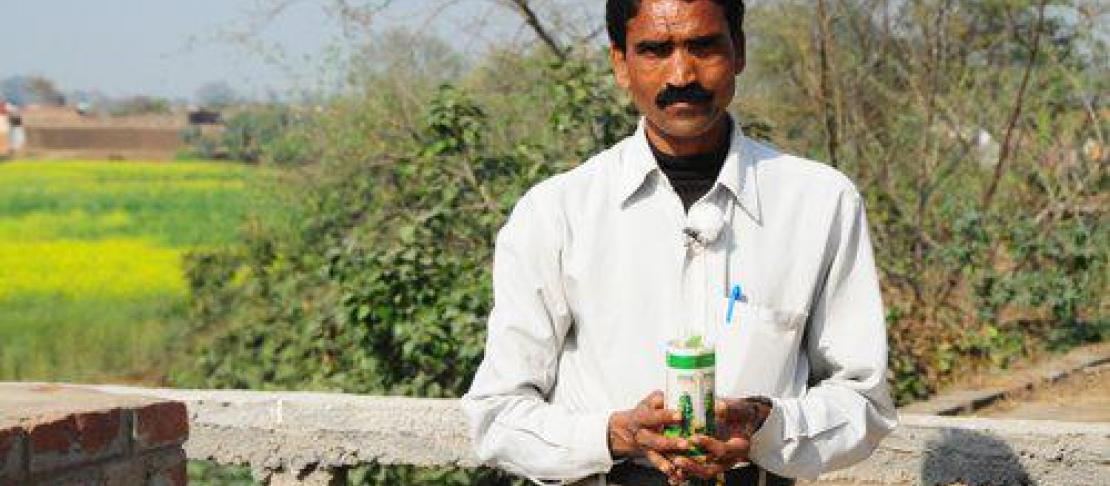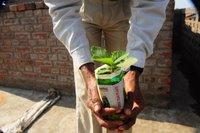Teak trees or food crops: Will climate change force farmers to make a choice?

One or two generations ago, smallholder farmers might have grown food crops mainly to feed their own families. But those days are gone. Farmers are looking more and more for cash income.
Like in Bihar, North-Central India: farmers still value the “yield” of a crop, but the “revenue” becomes increasingly important. It is not just because of the “Modern Times”, where electricity bills and school fees are to be paid, and people want to buy a mobile phone, a television or a tractor.
No, there is more than that: climate change has chased up the expenses: boreholes, mechanical or electric pumps, hybrid seeds… Each of these has a price ticket attached to it. A price ticket, farmers are scrambling to pay, but a necessity for any land to bare any crop.
The droughts
A good crowd had gathered in Rambad, a small village in Bihar. Both young and old, from the better-off farmers to the day labourers, all were sitting around us. We were talking about the change in weather, the effects it had on this farmers’ community and ways these people have tried to adapt over time.
When we asked who of the farmers had experimented with new things in the past years, they pointed out a slim man, probably in his late thirties, standing in a bit of a distance. As we all looked at him, he came nearer, stood up straight and held his arms stiff along his body as he said his name, “Vidyabhushan Kumar”, in a loud voice. As if a teacher had just summoned him. We asked Vidyabhushan to sit with us and tell his story.
At first, his story did not differ much from many others we heard in North India: He had a small plot of land, shared with his brothers, where they used to crop wheat and maize. In the past years, the rains have become less predictable: the monsoon comes later, and is shorter. Water has become scarce. The yearly floods bringing in new soil and moisture to the fields are a thing of the past now.
The expenses
“Nowadays, no borehole, no crops”, Vidyabhushan explained, “We need to irrigate our fields, so we have to pump water from the boreholes. But it costs money to dig  a borehole. Pump sets are expensive too. They require diesel to run, and need maintenance. All of that costs money, money we need to get from what we produce. No matter what we produce, we need to look at the market value; we look at the revenue it brings.”
a borehole. Pump sets are expensive too. They require diesel to run, and need maintenance. All of that costs money, money we need to get from what we produce. No matter what we produce, we need to look at the market value; we look at the revenue it brings.”
In the past years, Vidyabhushan started to crop vegetables after the wheat and maize harvest. “I can get several crops of vegetables before I need to sow wheat again”, he said, “but still that is not enough to provide an income for my family. I needed more.”
Teak, a new source of income.
He took us to the flat roof of his house. In a corner about one hundred small seedlings stood together.
 “Teak”, he said, “These are teak seedlings. You see, I calculated: I can buy these at 76 rupees a piece (about US$ 2). The tree needs 10 years to mature, and its timber will bring me 30,000 to 40,000 rupees (US$750 to US$1,000) for each tree. If I plant teak trees on the border of my field, about 6 feet apart, I can plant one hundred teak trees. This will give me a cash revenue of about 300,000 rupees (US$7,500) per year.”
“Teak”, he said, “These are teak seedlings. You see, I calculated: I can buy these at 76 rupees a piece (about US$ 2). The tree needs 10 years to mature, and its timber will bring me 30,000 to 40,000 rupees (US$750 to US$1,000) for each tree. If I plant teak trees on the border of my field, about 6 feet apart, I can plant one hundred teak trees. This will give me a cash revenue of about 300,000 rupees (US$7,500) per year.”
“There is a big teak market abroad, so the resale value is almost guaranteed.” Vidyabhushan smiled, “ But my risks are low. Teak trees don’t need a lot of water, and they don’t conflict with my other crops. The trees can just grow on the edge of my fields. These trees will bring me the cash I need, both for my family, and to counter the increased expenses I have with my other crops. ”
The future: cash or food?
 He kneeled down to pick up one of the seedlings. I noticed how careful and softly he handles the tiny plant as he shows it to me. It was as if he was holding his future in his hands.
He kneeled down to pick up one of the seedlings. I noticed how careful and softly he handles the tiny plant as he shows it to me. It was as if he was holding his future in his hands.
When we thanked him for the interview, he said “No, don’t go yet, I still want to show you my field, and my crops.” Vidyabhushan smiled as he walked through his vegetable patch: “You see, we can’t eat timber, we can’t eat money. No matter how the market would change, no matter of the revenue teak would bring me, I still need to feed my family. And for that I need to grow food, not just timber!”
But maybe, he is the last generation to still think so. Maybe, as the climate changes, erratic rains, droughts and pests might push farmers’ expenses even higher. Would the next generation of farmers then think of “Revenue only”-crops? What would happen then if they’d stop growing food crops? What would happen if smallholder farmers would switch to non-food crops on a large scale?
The way ahead for researchers and smallholder farmers facing current and coming challenges posed by climate change lies in learning from each other while sharing knowledge and experiences.
Photo in this article by Peter Casier.


